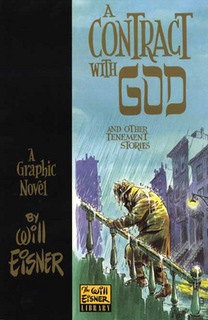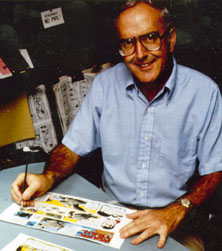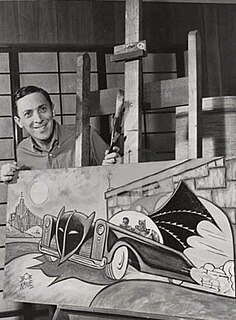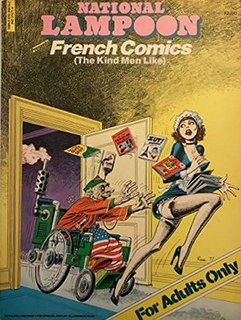
A comic strip is a sequence of drawings, often cartoon, arranged in interrelated panels to display brief humor or form a narrative, often serialized, with text in balloons and captions. Traditionally, throughout the 20th and into the 21st century, these have been published in newspapers and magazines, with daily horizontal strips printed in black-and-white in newspapers, while Sunday papers offered longer sequences in special color comics sections. With the advent of the internet, online comic strips began to appear as webcomics.

A cartoon is a type of illustration, sometimes animated, typically in a non-realistic or semi-realistic style. The specific meaning has evolved over time, but the modern usage usually refers to either: an image or series of images intended for satire, caricature, or humor; or a motion picture that relies on a sequence of illustrations for its animation. Someone who creates cartoons in the first sense is called a cartoonist, and in the second sense they are usually called an animator.

National Lampoon was an American humor magazine which ran from 1970 to 1998. The magazine started out as a spinoff from the Harvard Lampoon. National Lampoon magazine reached its height of popularity and critical acclaim during the 1970s, when it had a far-reaching effect on American humor and comedy. The magazine spawned films, radio, live theatre, various sound recordings, and print products including books. Many members of the creative staff from the magazine subsequently went on to contribute creatively to successful media of all types.

A graphic novel is a book made up of comics content. Although the word "novel" normally refers to long fictional works, the term "graphic novel" is applied broadly and includes fiction, non-fiction, and anthologized work. It is, at least in the United States, distinguished from the term "comic book", which is generally used for comics periodicals.

A cartoonist is a visual artist who specializes in drawing cartoons or comics. Cartoonists include the artists who handle all aspects of the work and those who contribute only part of the production. Cartoonists may work in many formats, such as booklets, comic strips, comic books, editorial cartoons, graphic novels, manuals, gag cartoons, illustrations, storyboards, posters, shirts, books, advertisements, greeting cards, magazines, newspapers, and video game packaging.

Fritz the Cat is a comic strip created by Robert Crumb. Set in a "supercity" of anthropomorphic animals, the strip focused on Fritz, a feline con artist who frequently went on wild adventures that sometimes involved sexual escapades. Crumb began drawing this character in homemade comic books when he was a child. Fritz became one of his best known characters, thanks largely to the motion picture adaptation by Ralph Bakshi.

Robert Kane was an American comic book writer, animator and artist who co-created, with Bill Finger, the DC Comics character Batman. Kane also co-created the animated series Cool McCool. He was inducted into the comic book industry's Jack Kirby Hall of Fame in 1994 and into the Will Eisner Comic Book Hall of Fame in 1996.

An American comic book is a thin periodical originating in the United States, on average 32 pages, containing comics. While the form originated in 1933, American comic books first gained popularity after the 1938 publication of Action Comics, which included the debut of the superhero Superman. This was followed by a superhero boom that lasted until the end of World War II. After the war, while superheroes were marginalized, the comic book industry rapidly expanded and genres such as horror, crime, science fiction and romance became popular. The 1950s saw a gradual decline, due to a shift away from print media in the wake of television and the impact of the Comics Code Authority. The late 1950s and the 1960s saw a superhero revival and superheroes remained the dominant character archetype throughout the late 20th century into the 21st century.

William Henry Jackson Griffith is an American cartoonist who signs his work Bill Griffith and Griffy. He is best known for his surreal daily comic strip Zippy. The catchphrase "Are we having fun yet?" is credited to Griffith.

The term adult comics typically denotes comic books, comic magazines, comic strips or graphic novels with content of an erotic, violent, or sophisticated nature marketed by publishers toward adult readers. They are sometimes restricted to purchase by legal adults, especially erotic comics which include sexually explicit material.
Ralph Reese is an American artist who has illustrated for books, magazines, trading cards, comic books and comic strips, including a year drawing the Flash Gordon strip for King Features. Prolific from the 1960s to the 1990s, he is best known for his collaboration with Byron Preiss on the continuing feature "One Year Affair", serialized in the satiric magazine National Lampoon from 1973 to 1975 and then collected into a 1976 book.
Shary Flenniken is an American editor-writer-illustrator and underground cartoonist. After joining the burgeoning underground comics movement in the early 1970s, she became a prominent contributor to National Lampoon and was one of the editors of the magazine for two years.

Conan the Barbarian by Robert E. Howard was first adapted into comics in 1952 in Mexico. Marvel Comics began publishing Conan comics with the series Conan the Barbarian in 1970. Dark Horse Comics published Conan from 2003 to 2018, after which the rights were reacquired by Marvel Comics.

Ed Subitzky, full name Edward Jack Subitzky, is an American writer and artist. He is best known as a cartoonist, comics artist, and humorist. He has worked as a television comedy writer and performer, a writer and performer of radio comedy, and a writer of radio drama. He has also created comedy and humor in other media. Subitzky is a member of the Screen Actors Guild-American Federation of Television and Radio Artists, and the Writers Guild of America.
The history of comics has followed different paths in different parts of the world. It can be traced back to early precursors such as Trajan's Column, in Rome, Egyptian hieroglyphs and the Bayeux Tapestry.

"Superduperman" is a satirical story by Harvey Kurtzman and Wally Wood that was published in the fourth issue of Mad. Lampooning both Superman and Captain Marvel, it revolutionized the types of stories seen in Mad, leading to greatly improved sales. Writers such as Alan Moore have cited this story as an influence.

National Lampoon Tenth Anniversary Anthology 1970–1980 was an American humor book that was published in hardback in December 1979 by Simon & Schuster. Although it appeared to be a regular book, it was a "special issue" of National Lampoon magazine. It was available for purchase on newsstands, not in bookstores. The National Lampoon "special issues" were published in addition to the 12 regular monthly issues of the magazine.

The Best of National Lampoon #3 was an American humor book published in 1973. The book was an anthology of articles from National Lampoon magazine. It was sold on newsstands, but was published in parallel with the regular issues of the magazine. The book is a "best-of" compilation of pieces that had already been published in the National Lampoon. The pieces were from various 1971 and 1972 (monthly) issues of the magazine.

National Lampoon Presents French Comics is an American humor book first published in 1977 in hardcover. It was a spin-off of National Lampoon magazine. The book is a collection of translated comics by French comic book artists and cartoonists of the 1970s, including Gérard Lauzier, Moebius, Guido Buzzelli, Nikita Mandryka, Sole, Lozo, Jean-Claude Forest, Alexis, and Gotlib. The words were translated by Sophie Balcoff, Valerie Marchant, and Sean Kelly. Peter Kaminsky was the editor.
Canadian comics refers to comics and cartooning by citizens of Canada or permanent residents of Canada regardless of residence. Canada has two official languages, and distinct comics cultures have developed in English and French Canada. The English tends to follow American trends, and the French Franco-Belgian ones, with little crossover between the two cultures. Canadian comics run the gamut of comics forms, including editorial cartooning, comic strips, comic books, graphic novels, and webcomics, and are published in newspapers, magazines, books, and online. They have received attention in international comics communities and have received support from the federal and provincial governments, including grants from the Canada Council for the Arts. There are comics publishers throughout the country, as well as large small press, self-publishing, and minicomics communities.
















